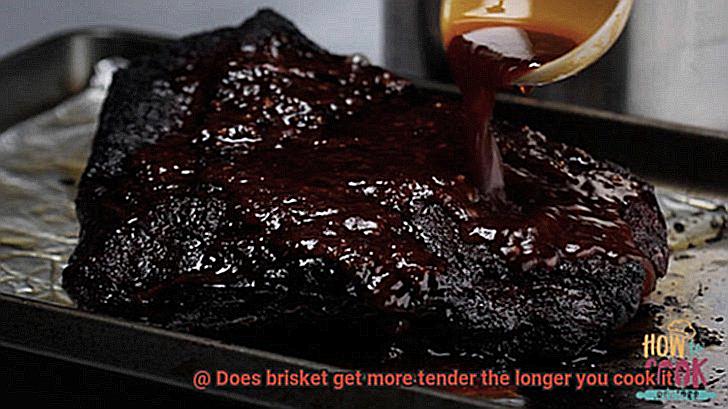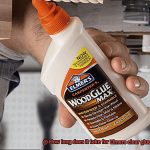Hot glue is the go-to adhesive for DIY enthusiasts and crafters alike. Its versatility and ease-of-use make it a popular choice for bonding different materials quickly and efficiently. But, let’s face it, we’ve all wondered at some point – how water-resistant is hot glue?
If you’re planning to use hot glue on a project that may come into contact with water or moisture, you might be anxious about its durability. Hot glue has unique properties, but can it hold up in wet environments?
In this blog post, we’ll dive deep into the world of hot glue and explore its resistance to water. We’ll investigate the impact of various factors such as temperature, surface type, and different types of hot glue on its adhesion strength. Plus, we’ll share some tips and tricks to increase the water resistance of your hot glue projects.
So if you’re looking for answers on how to make your DIY projects waterproof with hot glue, keep reading. We’ve got everything you need to know about using this adhesive in damp or wet environments.
The Different Types of Hot Glue
Contents
- 1 The Different Types of Hot Glue
- 2 Factors That Impact the Water Resistance of Hot Glue
- 3 How to Test the Water Resistance of Hot Glue
- 4 Hot Glue vs Other Adhesives for Water Resistance
- 5 Pros and Cons of Using Hot Glue for Water-Resistant Projects
- 6 Tips for Improving the Water Resistance of Hot Glue
- 7 Common Mistakes to Avoid When Working with Hot Glue
- 8 Conclusion
Hot glue is a versatile adhesive that has become a staple in the world of DIY projects, crafts, and home repairs. It is loved for its strong bonding capabilities and quick drying time. However, not all hot glue is created equal when it comes to water resistance.
To avoid any mishaps, it is essential to understand the different types of hot glue available on the market and their respective levels of water resistance.
Standard Hot Glue
Standard hot glue is the most commonly used type of hot glue. It is relatively inexpensive and can be used for a wide range of projects, from crafting to woodworking. Standard hot glue is water-resistant, but it is not completely waterproof.
While it can withstand some exposure to moisture without losing its adhesive properties, prolonged exposure to water can cause it to break down and lose its grip.
Low-Temperature Hot Glue
Low-temperature hot glue is designed for use with heat-sensitive materials that could be damaged by the high temperatures required for standard hot glue. This type of glue has a lower melting point which makes it ideal for delicate materials such as foam, lace, and ribbon.
However, because it is not as strong as standard hot glue, it may not be suitable for all projects. Additionally, low-temperature hot glue may not be as water-resistant as high-temperature hot glue.
High-Temperature Hot Glue
For projects that require a stronger bond, there is high-temperature hot glue. This type of glue has a higher melting point than standard hot glue, making it more durable and able to withstand more stress.
High-temperature hot glue is also water-resistant but like standard hot glue, it is not completely waterproof. It can withstand exposure to rain and other elements, making it ideal for outdoor use.
Specialty Hot Glue
Specialty hot glues are formulated for specific applications such as fabrics or plastics. These glues have different properties than standard hot glue and are designed to work best with certain types of materials.
Some specialty hot glues may also offer superior water resistance compared to standard or low-temperature hot glue. It is important to choose the appropriate specialty hot glue for the specific material being used and the conditions the project will be exposed to.
Type of Adhesive
The type of adhesive used in hot glue formulation can also affect its water resistance. Some hot glues contain synthetic polymers that offer superior water resistance compared to natural adhesives such as animal-based glues. When selecting a hot glue for a project, it is important to consider the specific requirements of the project and choose a glue that is appropriate for the materials being used and the conditions the project will be exposed to.
So, hot glue is generally considered to be water-resistant, but the degree of resistance can vary depending on several factors.
Factors That Impact the Water Resistance of Hot Glue
Hot glue is a popular adhesive that has become a go-to for quick bonding of various materials. It’s strong, versatile, and can be used for anything from crafting to home repairs. However, did you know that hot glue’s water resistance can vary depending on several factors? Let’s dive into the main factors that impact the water resistance of hot glue.
Firstly, the type of hot glue used can affect its water resistance. Low-temperature hot glue has a lower melting point and is suitable for delicate materials like fabric and foam, while high-temperature hot glue has a higher melting point and is perfect for bonding stronger materials like metal and plastic. When it comes to water resistance, high-temperature hot glue reigns supreme.
Secondly, surface preparation is crucial in determining the water resistance of hot glue. The surface should be clean, dry, and free of any contaminants like dust, grease, or oil. Failing to prepare the surface correctly can result in reduced bond strength and ultimately impact the water resistance of hot glue.
Thirdly, the application method used to apply the hot glue can also impact its water resistance. Applying too little or too much hot glue can result in weak bonds that will not withstand water exposure. So, it’s essential to apply an even layer of hot glue to create a strong bond that can resist water.
Temperature and humidity are also significant factors affecting the water resistance of hot glue. Extreme temperatures can cause hot glue to expand or contract, which can weaken its bond strength over time. Similarly, high humidity levels can also affect the bond strength and water resistance of hot glue.
How to Test the Water Resistance of Hot Glue
Hot glue is a versatile adhesive that is commonly used in numerous DIY projects, crafts, and repairs. However, one of the concerns about hot glue is its water resistance. It is important to test the water resistance of hot glue to ensure its durability and longevity in damp or wet conditions.
In this article, we will discuss five sub-sections detailing the steps and materials needed to test the water resistance of hot glue.
Materials Needed
To test the water resistance of hot glue, you will need a few materials such as a small dish or container, water, and a piece of paper or fabric to apply the glue onto. It’s important to note that different types of hot glue may have different levels of water resistance. Always check the manufacturer’s instructions and recommendations before using hot glue in wet conditions.
Submersion Test

The submersion test is the simplest method for testing the water resistance of hot glue. Apply a small amount of hot glue onto the paper or fabric and let it dry completely. Once dry, fill a dish or container with water and submerge the glued area for at least 30 minutes. After 30 minutes, remove the paper or fabric from the water and let it dry completely.
Spray Test
The spray test is a more effective method for testing larger objects or surfaces. Use a spray bottle or hose to directly apply water to the glued area and observe any changes or damage.
Inspecting for Damage
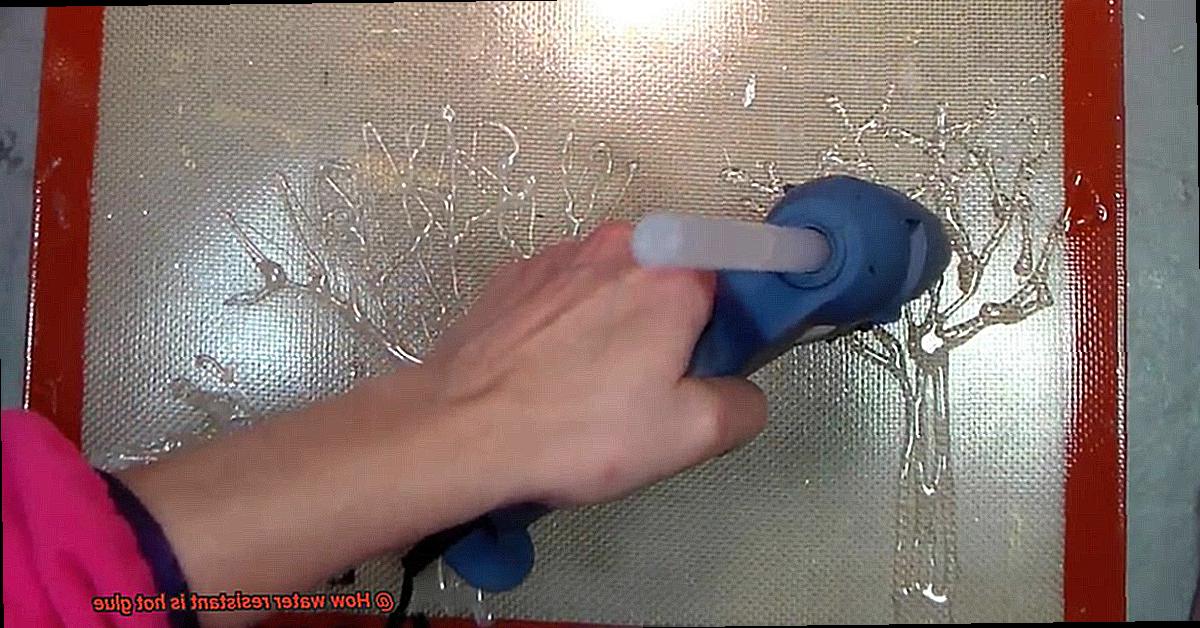
After drying, inspect the glued area for any signs of damage or failure such as peeling, bubbling, or separation. If the glue has remained intact and shows no signs of damage, it has passed the water resistance test. However, if there are any signs of damage, then the glue is not water-resistant and should not be used in wet conditions.
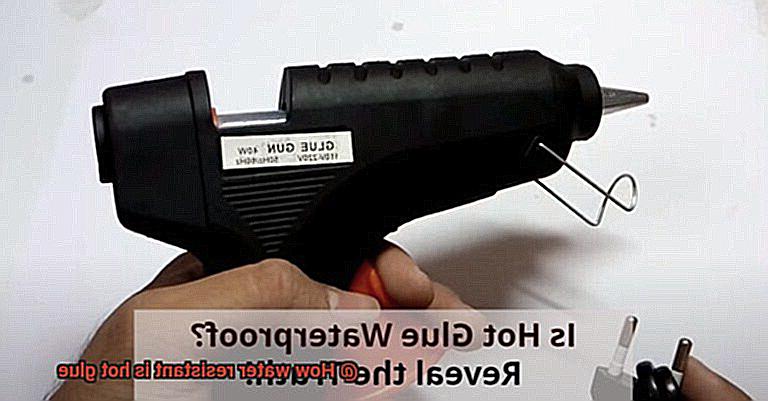
Types of Hot Glue
The type of hot glue used will affect its water resistance. Some types of hot glue are specifically designed for water resistance, while others may not be as effective. It’s important to choose the right type of hot glue for the intended application and environment.
Hot Glue vs Other Adhesives for Water Resistance
If you’re working on a project that requires water resistance, the type of adhesive you choose could make all the difference. While hot glue is often praised for its versatility and ease of use, it may not be the most suitable option for long-term water resistance. So what are the differences between hot glue and other adhesives when it comes to withstanding water?
Epoxy is a two-part adhesive that creates an incredibly strong bond and is highly resistant to water. It’s perfect for sealing leaks, repairing boats, and bonding metals, making it a great choice for projects that require constant exposure to water.
Super glue, or cyanoacrylate adhesive, is another option that’s resistant to water. It forms a quick-drying bond with surfaces such as plastic, metal, and rubber, making it ideal for occasional exposure to water.
Silicone adhesive is another popular choice for water-resistant applications. It can seal gaps and joints in bathrooms and kitchens and is even used in aquariums and other underwater applications. Its design specifically resists water damage, making it a fantastic choice for long-term water-resistant projects.
Hot glue may withstand some exposure to water, but it may eventually break down or lose its strength over time. For that reason, hot glue is better suited for temporary or indoor applications where water exposure is minimal.
Pros and Cons of Using Hot Glue for Water-Resistant Projects
Hot glue might be on your list of choices, but before making a decision, it’s important to understand the pros and cons of using hot glue for water-resistant projects.
Let’s begin with the advantages. Firstly, hot glue has a rapid drying time, which is useful for projects that require a fast bond. Secondly, it has a strong adhesive bond that can withstand moderate exposure to water. Lastly, hot glue is versatile and can be used on various surfaces, making it an excellent option for water-resistant projects.
However, there are some downsides to using hot glue for water-resistant projects. The most significant disadvantage is its limited water resistance. While hot glue can handle moderate exposure to water, it is not entirely waterproof and will eventually break down with prolonged exposure. Additionally, hot glue is temperature-sensitive and can soften or melt in high temperatures, which can compromise its water resistance. Finally, hot glue is not recommended for submerged projects as it breaks down quickly under these conditions.
To sum up, when considering using hot glue for your water-resistant project, it’s important to weigh up the pros and cons. While it has many benefits, its limitations must be taken into account. It’s essential to consider the specific needs and conditions of your project before deciding on the appropriate adhesive.
Tips for Improving the Water Resistance of Hot Glue
Hot glue is a versatile adhesive that can be used for a wide range of projects. However, it’s not always the best choice when it comes to water resistance. Water exposure can weaken the bond of hot glue, causing your projects to fall apart. But don’t worry, there are several tips and tricks you can use to improve the water resistance of your hot glue projects.
Choose the Right Hot Glue
One essential tip to improve water resistance is to choose the right type of hot glue for your project. Not all hot glue sticks are created equal, and some have better water resistance than others.
Look for hot glue that is specifically labeled as waterproof or water-resistant. By using the appropriate type of hot glue, you’ll increase its ability to withstand exposure to water or humidity.
Clean and Dry Surfaces
Before applying hot glue, make sure the surfaces you’re bonding are clean and dry. Any moisture or dirt on the surface can weaken the bond and reduce the water resistance of the glue. Clean the surfaces thoroughly with a damp cloth or alcohol swab, and let them dry completely before applying hot glue.
Add a Sealant
Another useful tip is to add a sealant or coating over the hot glue once it has dried. This extra layer of protection can significantly increase the water resistance of your projects. Clear spray sealants or waterproofing sprays are ideal options that can be easily applied over the hot glue joint. Make sure to follow the manufacturer’s instructions carefully when using these products.
Mix in an Additive
You can also try mixing in an additive or filler with your hot glue to improve its water resistance. Additives like silica powder or acrylic fibers can enhance the strength and durability of the bond, making it more resistant to water damage. Mixing in these additives will also help fill any gaps and create a more solid bond.
Consider an Alternative Adhesive
If you need extra-strong water resistance for your project, consider using a different adhesive altogether. Epoxy and polyurethane adhesives are known for their excellent water resistance and may be a better option for certain projects. These adhesives may take longer to dry and require more preparation than hot glue, but they offer superior performance in wet conditions.
Common Mistakes to Avoid When Working with Hot Glue
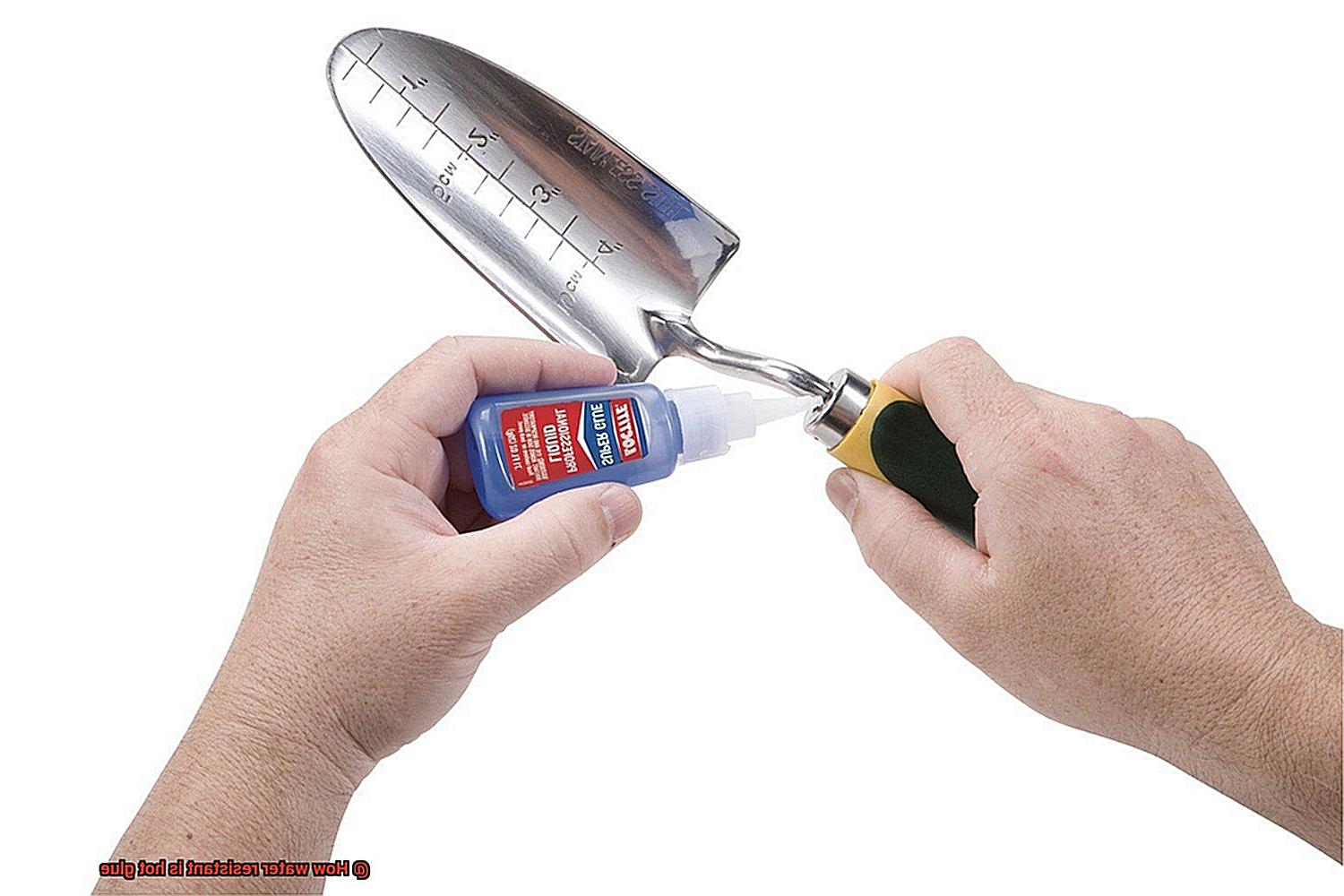
Hot glue is a versatile adhesive that can be used for a variety of projects, from crafting to home repairs. However, if you’re not careful, you might end up with a project that’s not as water-resistant as you’d like it to be. To help you avoid common mistakes when working with hot glue, we’ve compiled some tips and tricks to ensure your projects are properly sealed and water-resistant.
One of the most common mistakes people make is not using enough glue. It’s easy to underestimate how much glue is needed, but failing to use enough can result in an unsealed project that won’t hold up to moisture. To avoid this, make sure to use enough glue to cover the entire area that needs to be sealed.
Another mistake people make is using the wrong type of glue. Not all hot glues are waterproof, so it’s essential to choose a waterproof or water-resistant hot glue if your project will be exposed to moisture.
Applying the glue too thinly is another mistake people often make. A thin layer of glue may not create a strong enough bond, which can compromise its water resistance. To ensure the best results, apply the glue in a thick and even layer.
Finally, applying the glue too quickly can also affect its water resistance. If you don’t allow the glue enough time to cool and set properly before exposing it to water, it may not hold up as well as it should. Take your time and allow the glue to cool and harden completely before testing its water resistance.
Also Read: Is Super Glue Waterproof? – Glue Things
Conclusion
In summary, hot glue is a versatile adhesive that has gained popularity for its quick-drying and easy-to-use properties. However, when it comes to water resistance, not all hot glues are created equal. The degree to which hot glue can resist water depends on various factors such as surface preparation, application method, temperature, humidity, and the type of hot glue used.
To achieve optimal results with hot glue in water-resistant projects, it’s crucial to choose the appropriate type of hot glue for the material being used and the environmental conditions it will be exposed to. Proper surface cleaning and drying prior to application can also significantly enhance its water resistance. Additionally, incorporating a sealant or additive into the glue mixture can further improve its ability to withstand moisture.
Despite its many advantages in crafting and DIY projects, hot glue may not be suitable for long-term exposure to water. In such cases, epoxy, superglue or silicone adhesives may offer superior water resistance compared to hot glue. Understanding the strengths and limitations of each adhesive option and following best practices when using them can help ensure your projects remain sealed against moisture damage.
In conclusion, while hot glue is generally considered water-resistant, taking additional precautions such as proper surface preparation and choosing the right type of adhesive can enhance its performance in wet environments.

